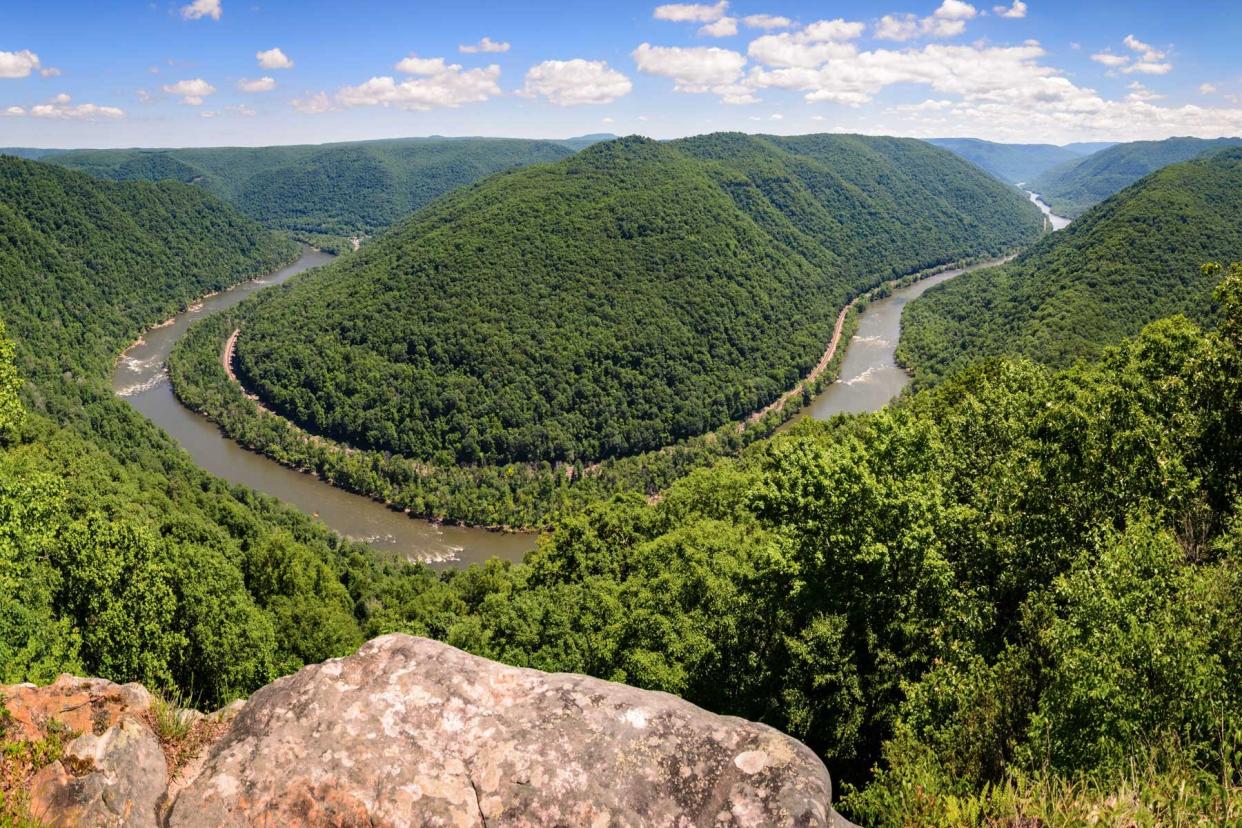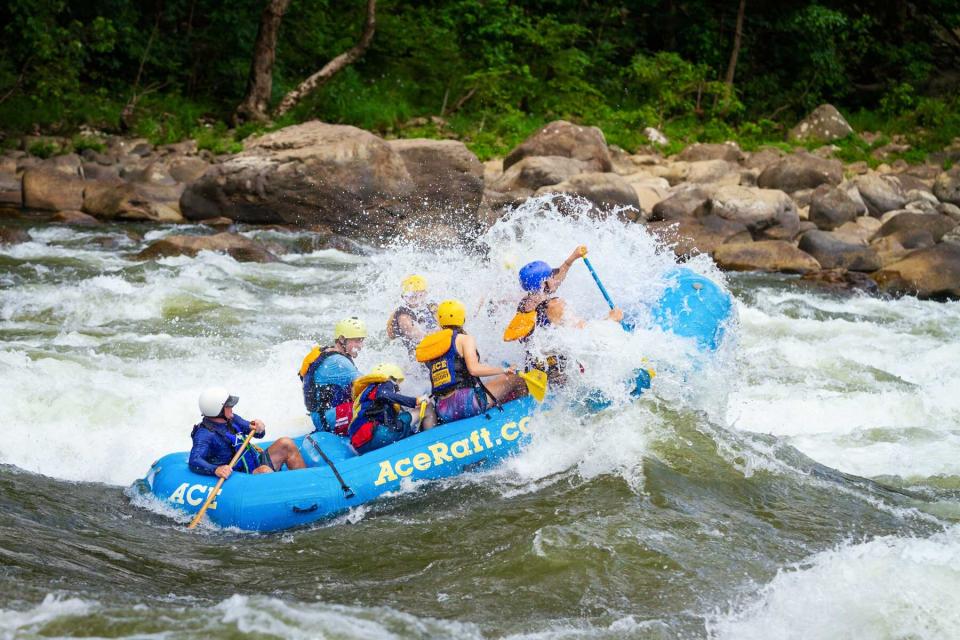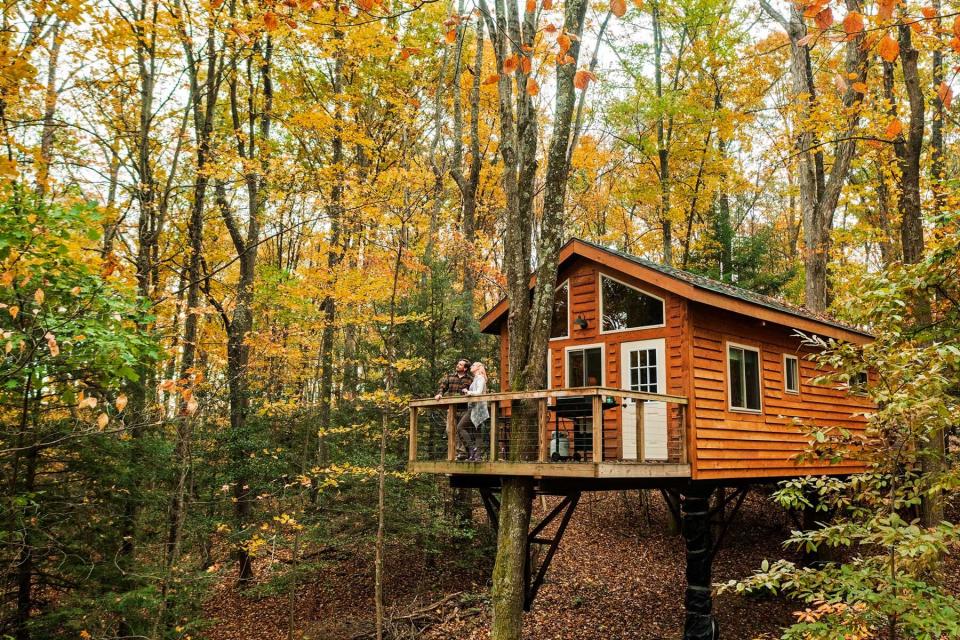I Went Whitewater Rafting, Sailed Down a Zip Line, and Slept in a Tree House in West Virginia's New National Park

Zack Frank/500px/Getty Images A bend in the river at Grandview, in New River Gorge National Park & Preserve.
I'd been warned that most first-timers get tossed out of the raft at some point, but it was still a shock when, after a particularly raucous spin in a Class III rapid on the New River in West Virginia, I found myself underneath the big blue boat I had been sitting in just seconds ago. I felt along the bottom of the raft blindly, but since it was moving through a sort of whirlpool, I struggled to get a hold.
Then, in a euphoric flash, my fingers found the edge and I pushed myself out from under the boat. My helmet broke the surface of the water, and I took in a gasp of air, bobbing up and down as I began to drift downstream. I watched my guide, Liam Mulligan, maneuver the raft toward me. Grabbing the shoulders of my life vest, he hauled me back in.
"How was that?" he asked, grinning, as I flopped down like a stunned fish.
"Crazy," I said, trying to catch my breath. "And kind of fun."
The New River is actually one of the oldest rivers in the world. By most estimates, it was formed 320 million years ago and pre-dates the Appalachian Mountain range it flows through on its journey from its source in North Carolina. In 1978, a 53-mile section of the waterway in West Virginia was established as the New River Gorge National River. With some of the finest stretches of whitewater in the country, it has for decades been beloved by rafting enthusiasts. The area is also popular with rock climbers, mountain bikers, and hikers. The general public took note of it in December 2020, when the river was designated America's 63rd national park. Visitation exploded — thanks, in part, to the pandemic: in 2021, nearly 1.7 million people visited, a 60 percent increase over the previous year.

Courtesy of Ace Adventure Resort Splashing through the rapids on the New River.
Last July, I went to Fayetteville, West Virginia, the tiny gateway town at the northwestern edge of the gorge, to explore the new park. There are no in-park accommodations, but Fayetteville has plenty of places to stay, like the apartment-style Lafayette Flats (lafayetteflats.com; doubles from $169), where I ended my strenuous days by relaxing in a soaking tub, and Country Road Cabins (wvcabins.com; cabins from $159), where I spent a night in a cozy tree house. Wherever I was, it didn't take long to find moments of solitude. The park, which hugs the river, is a long and narrow slice of wilderness — one where it's easy to feel lost, in a good way.
"Remember, make a starfish if you see us doing it," said Carlee Evans, one of my zip lining guides, who was waiting several hundred feet away. If I was going too fast, she would spread out her arms and legs as a cue for me to slow down by doing the same. As I stepped to the edge of the platform, I tried not to think about the forest floor below. Eventually, I took the plunge, racing through the canopy and catching glimpses of the gorge beyond.
Related: Enjoy a Taste of Appalachia on a Culinary Road Trip Through West Virginia
I was on the first leg of an overnight journey called Zips and Dips offered by ACE Adventure Resort (aceraft.com; overnight package from $279). I spent the afternoon zip lining, then headed down to a riverside camp for the night before tackling the whitewater the next day. I shared the adventure with a family of three from Ohio — mom Sonia, dad Pat, and college-age daughter Cassie — who were great sports about having a stranger tag along on their vacation. They assured me that I would (probably) not die during any of these wild pursuits.
Both Sonia and I were a little intimidated by zip lining, but became instant comrades, shuffling toward the back of the group and letting braver souls go first. After a few high-flying hours, the four of us met our rafting guides, Mulligan and Jeff Cogle. They were going to brief us on what to expect on the next day's journey, but first they were going to feed us: two trays of loaded nachos off the grill, followed by a dinner of steak, baked potatoes, corn on the cob, salad, and garlic bread.
While we chowed down, Cogle, a native West Virginian who's been guiding river trips for 30 years, told us about the area's mining history. The New River Gorge once contained some of the best coal reserves in the state; at one point, there were 40 coal-mining towns along the river. The mines are now closed, and many have been overtaken by nature.
The next morning, our bellies filled with a country breakfast, we launched our rafts near the abandoned town of Thurmond, once a railroad hub for transporting coal. Mulligan captained a passenger boat with Sonia, Pat, Cassie, and me, while Cogle tagged behind solo in a smaller raft with the food, first-aid kit, and radio equipment. The morning was slow-moving and blissful: we watched a bald eagle soar, then got out of the raft to jump off rocks and swim, letting the gentle current carry us downstream. At times the gorge — between 900 and 1,500 feet deep in places — narrowed dramatically at the bottom, and we could only see a few yards ahead of us; at other points it opened into a dramatic expanse, and we could gaze downstream for miles.
But the calm did not last. After passing the remnants of another mining town, we started hitting rapids. Mulligan directed us, yelling out instructions like "all forward!" when we were to attack the waves head on with our paddles. We rollicked through rapids with amusing (and occasionally troubling) names: Ender Waves, Pin Ball, Scramble Like a Rat.
Six hours in, we felt like seasoned pros (I was the only one who got dunked). When we hit one of the last big rapids — called Thread the Needle — perfectly, gliding the raft up and over the waves and rocks with ease, we all put our paddles together in a high five and whooped in celebration. It had been a 15-mile journey, and I leaped into the water, exhausted and exhilarated.

Courtesy of Country Road Cabins The Tuscany Tree House at Country Road Cabins.
Ten hours of sleep and a strong cup of coffee later, I was hiking the park's popular Endless Wall Trail with Jodi French-Burr, a ranger who has been stationed at New River since 1988. As we walked, she told me about the local ecology, pointing out bushes of pink rhododendron, West Virginia's state flower. From the overlook at Diamond Point, we stared down 900 feet at tiny orange specks dotting the whitewater — they were rafters, navigating a rapid I'd done the day before. It was a thrill to think about how much of the gorge I'd seen in just two days.
Then it was time to hustle over to Arrowhead Bike Farm (arrowheadbikefarm.com), a campground and mountain-bike shop in Fayetteville that also has a restaurant and craft-beer bar. After zip lining, rafting, and hiking, biking was the last box to check on my multisport tour of the gorge. My guide, Travis Brown, who directs the Farm's bike clinics, took me out for a spin on the Long Point Trail. Gripping my handlebars and bracing for impact, I let out a yelp as I plunged through the woods, watching the ground ahead to avoid rocks and roots.
Related: 10 Best National Parks in the U.S. You Should Visit
Some 1.3 skull-rattling miles later, we left our bikes and walked to a rocky outcrop where the view opens up. From there, it was easy to see why the New River Gorge Bridge has become one of the most photographed sites in the state: at more than 3,000 feet long and 876 feet high, it's a breathtaking sight. (I later learned that it's the largest single-span steel-arch bridge in the Western Hemisphere.) Before its completion in 1977, crossing the river required a winding, 45-minute journey by car, descending steeply from one side of the gorge, bumping over a rickety wooden bridge, and ascending the other side; now it takes 45 seconds.
I remembered how, as my rafting trip ended the day before, I had jumped out of the boat and dipped my head back. As the water cradled my body, I had looked up at the bridge. Now I gazed out at that same hulk of steel, nearly at eye level with it, in a full-circle moment of awe.
A version of this story first appeared in the June 2022 issue of Travel + Leisure under the headline Rapid Transformation.

